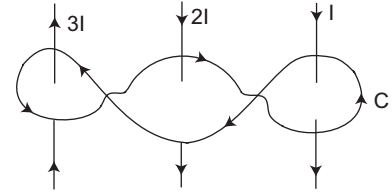Electromagnetic theory miscellaneous
- A-TEM wave incident normally upon a perfect conductor the E and H fields at the boundary will be respectively—
-
View Hint View Answer Discuss in Forum
At boundary the fields are in phase opposition 180º out of phase and whole energy is reflected back for perfect conductor. Hence E and H fields at the boundary will be maximum and minimum respectively.
Correct Option: D
At boundary the fields are in phase opposition 180º out of phase and whole energy is reflected back for perfect conductor. Hence E and H fields at the boundary will be maximum and minimum respectively.
- The magnitude of open circuit and short circuit input impedances of a transmission line are 100 Ω and 25 Ω respectively the characteristic impedance of the line is—
-
View Hint View Answer Discuss in Forum
Characteristic impedance is given in terms of short circuit and open circuit impedance Zc =√ZSCZOC = √25 × 100 = √2500 = 50Ω
Correct Option: B
Characteristic impedance is given in terms of short circuit and open circuit impedance Zc =√ZSCZOC = √25 × 100 = √2500 = 50Ω
- Find Q of the coil at resonance having frequency 1 MHz—

-
View Hint View Answer Discuss in Forum
At resonance XL = XC
jωL = 1 jωC
orL = 1 = 1 ω20C (2∏ × 106)2 × 50 × 10−12 = 1 50 × 4∏2 Q = ω20L = 106 × 2∏ × 1 R 10 50 × 4∏2 = 103 ∏ Correct Option: A
At resonance XL = XC
jωL = 1 jωC
orL = 1 = 1 ω20C (2∏ × 106)2 × 50 × 10−12 = 1 50 × 4∏2 Q = ω20L = 106 × 2∏ × 1 R 10 50 × 4∏2 = 103 ∏
- Consider the following statements: For electromagnetic waves propagating in free space:
1. Electric field is perpendicular to direction of propagation.
2. Electric field is along the direction of propagation.
3. Magnetic field is perpendicular to direction of propagation.
4. Magnetic field is along the direction of propagation.
Which of these statements are correct?
-
View Hint View Answer Discuss in Forum
NA
Correct Option: A
NA
- The circulation of →H around the closed contour C, shown in the figure is—

-
View Hint View Answer Discuss in Forum
NA
Correct Option: C
NA

